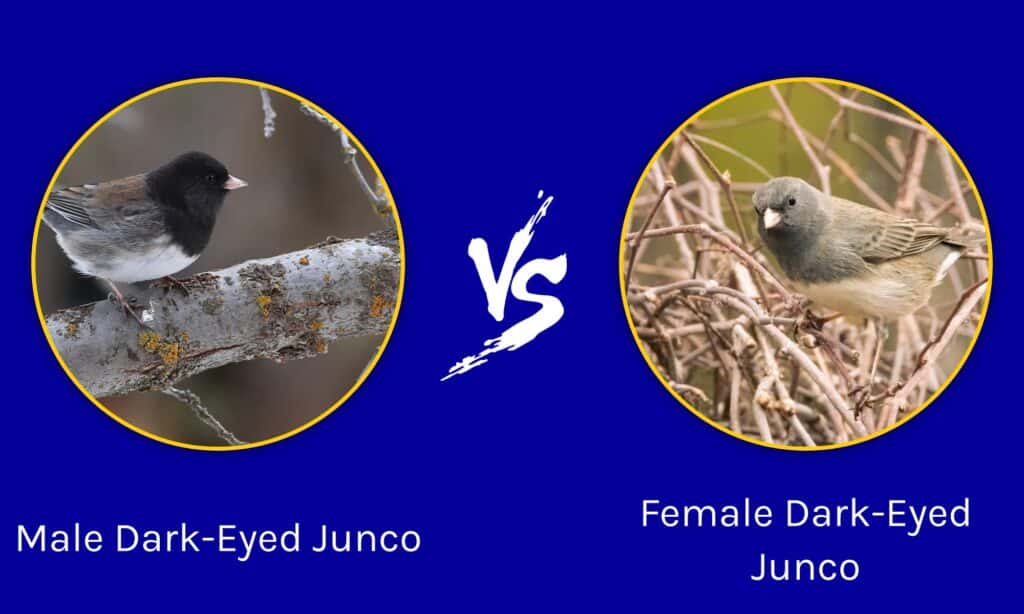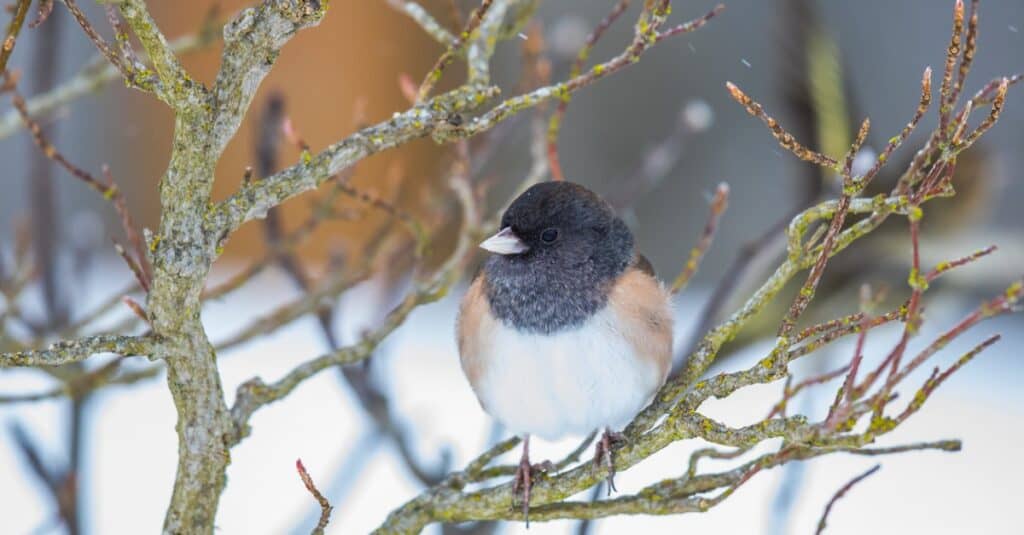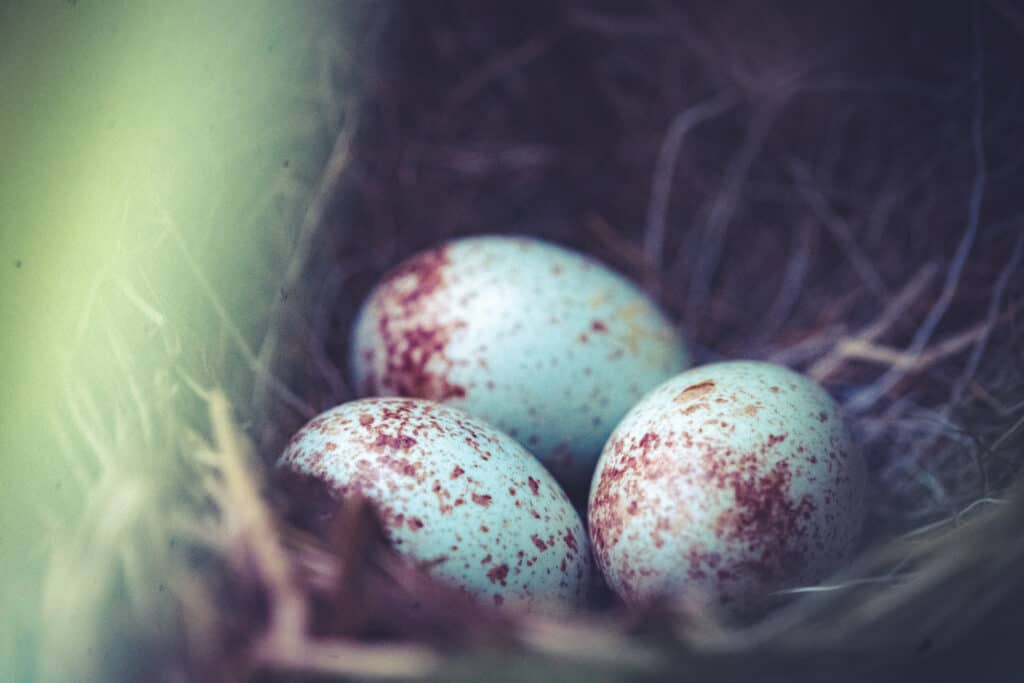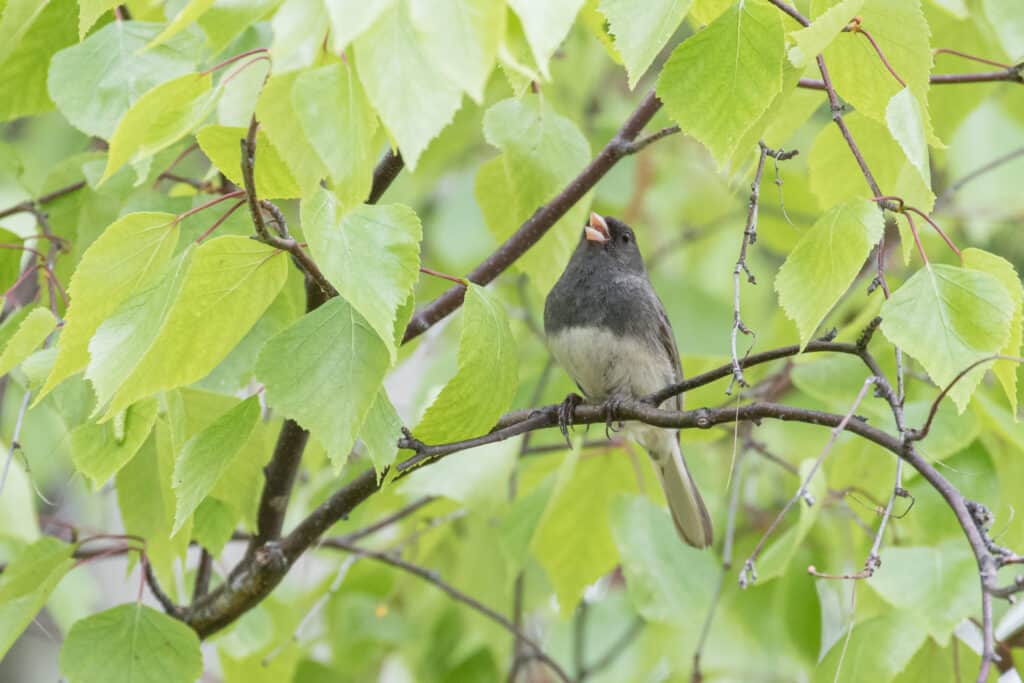Dark-eyed juncos can be recognized by their small, round frames and characteristic hops. They hop to and fro, forward and sideways along the ground and display a flash of white tail feathers when they decide to flutter away to a tree branch. They are spread out around the North American continent, with the variety in the East arriving with the first snowfall, giving them the nickname “snow bird.” There are several varieties in the west which are not necessarily associated with the snowfall. These varieties with their varied plumage look so distinct that they were considered separate species until the 1970’s. However they are actually subspecies and all of them will interbreed where their ranges meet.
Different varieties of dark-eyed juncos can be distinguished by their variable plumage coloration, but what about male vs female dark-eyed juncos? We’ll take a look at the physical and behavioral differences between them so that next time you’re bird watching you’ll be able to identify the genders when snowbirds are spotted.
Comparing a Male Dark-Eyed Junco and a Female Dark-Eyed Junco

| Male Dark-eyed Junco | Female Dark-eyed Junco | |
|---|---|---|
| Size | 4.9 to 6.5 in, 0.67 ounces | 4.9 to 6.5 in, 0.67 ounces |
| Morphology | Various patterning of gray, brown and white plumage. Bulging neck feathers. More rounded head profile. | Similar coloration but more subdued than males. Thinner necks. |
| Behavior | Tend to display a crouching and grounded, dominant posture. Defend the nests. | Tend to display a more upright posture. Active and fidgety. Build the nests |
| Vocalizations | Loud musical trill, also soft song of whistles, trills and warbles. | Soft song of whistles, trills and warbles. |
Key Differences Between a Male and Female Dark Eyed Junco
The key differences of male vs female dark-eyed junco are their coloration, posture and movement, behaviors during nesting, and their vocalizations. These birds are similar in size between the sexes and only have a slight difference in coloration. It takes patience and careful observation to distinguish between a male vs female dark-eyed junco, but the following information will provide you with the key to distinguishing between a male and a female in the wild.
Male vs Female Dark Eyed Junco: Size
In terms of size, there is no noticeable difference between male and female dark eyed juncos. This is not a feature that will help you determine the sex of the bird you are observing. As adults, they both have a body length of 4.9 to 6.5 inches and weigh an average of 0.67 ounces.
Male vs Female Dark Eyed Junco: Morphology

Male vs female dark eyed juncos have only slight differences in physical appearance.
©iStock.com/Jeff Huth
The Dark-eyed Junco is a medium-sized type of sparrow that has a rounded head, a short and stout bill and a long tail with a soft pink bill. Juncos in the East are known as slate-colored juncos. They are charcoal gray on top and have white bellies. Other varieties of the dark-eyed junco display various patternings of gray, brown and white hued plumage. Females display the same plumage patterning as the males. However, females tend to display more subdued hues than the males.
There is another interesting difference that some bird watchers have caught onto that can distinguish male vs female dark-eyed juncos. They often display consistently different postures. This may be a morphological trait, or it could be behavioral. After careful observation of groups of males and females, it has been noted that females tend to stand more upright with their heads held higher and their bodies higher off the ground. They have a slightly thinner neck, lacking the bulging neck feathers that male dark-eyed juncos display. Males head profiles are a bit more rounded than females, who show a very slight crest.
Male vs Female Dark Eyed Junco: Behavior

Female dark-eyed juncos typically construct the nest but the males will help to protect it and both feed the nestlings once hatched.
©Adeline Weyland/Shutterstock.com
In terms of movements, you may be able to distinguish a male from a female dark-eyed junco by the more active and fidgety tendencies of the female. Females are lower on the pecking order than males and are often chased by males, leading to this behavior. Males tend to display a crouching posture that is more grounded and dominant.
During courtship, both members of the pair will hop on the ground with their wings drooped and their tail spread widely to show off their white outer tail feathers. Males may produce a soft song to attract the females. After a successful pairing, female dark-eyed juncos tend to build the nests on their own. They are typically constructed on the ground, a small and well-hidden cup-like nest built of grass, weeds, leaves, hair and feathers. While the female takes the responsibility of building the nest, the male participates by guarding it. Both parents will feed the nestlings once they are hatched.
Male vs Female Dark Eyed Junco: Vocalizations

Both male and female dark-eyed juncos sing a quiet song made of whistles, trills and warbles, but males also produce a louder song at times.
©iStock.com/Dee Carpenter Photography
Males tend to sing from a perched location to defend the nesting territory. They sing a musical trill made up of 7 to 23 notes that lasts up to 2 seconds at a time. It is similar to the songs of the chipping sparrow and the pine warbler, and is typically loud enough to be heard from hundreds of feet away.
Both males and females sing a much quieter song that is a series of whistles, trills and warbles that can sound like an American goldfinch. This quieter song normally doesn’t carry more than about 40 feet. They both tend to use a high and short chip note in rapid succession as they fly and the same sound more slowly as they forage. This may be used to encourage others to follow their lead. A sharp ‘kew’ let out by a dominant bird tends to indicate aggression and urges birds to move apart. During altercations a fast twittering call of 6-19 notes may be used.
The photo featured at the top of this post is © iStock.com/graphicphoto
Thank you for reading! Have some feedback for us? Contact the AZ Animals editorial team.






